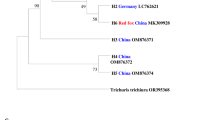Abstract
The damage to the tegument of 3-week-old Fasciola hepatica was evaluated by scanning electron microscopy (SEM) following treatment with the 5-chloro-2-methylthio-6-(1-naphtyloxy)-1H-benzimidazole (called compound alpha) in its natural host. For the present study, flukes were raised in pelibuey sheep infected orally with metacercariae of F. hepatica; the parasites were recovered from the liver of the sacrificed sheep after 6, 12 and 24 h of treatment with compound alpha. At 6 h of treatment, the flukes showed some lesions on the ventral surface of the anterior region, such as a swollen tegument and blebs. At 12 h after treatment, the specimens showed structural disorganization and spine loss in the ventral anterior region. The tegument of the flukes treated for 24 h was completely lost in some areas of the ventral surface, leaving an exposed basal lamina. The tegument of immature F. hepatica might be a target organ for compound alpha to exert its fasciolicide effect.


Similar content being viewed by others
References
Anderson HR, Fairweather I (1988) Fasciola hepatica: scanning electron microscopic observations of juvenile flukes following treatment in vitro with the deacetylated (AMINE) metabolite of diamphenetide (DAMD). Int J Parasitol 18:822–837
Bennett JL, Kohler P (1987) Fasciola hepatica: action in vitro against triclabendazole on immature and adult stages. Exp Parasitol 63:49–57
Dalton JP (1999) Fasciolosis. University Press, New York
Del Campillo C, Vazquez R (1999) Parasitologia Veterinaria. McGraw-Hill Interamericana, Madrid
Del Rivero LM (1998) Farmacocinetica del Alfa-BioF10 en borregos. MSc thesis, Faculty of Chemistry, National Autonomous University of Mexico, Mexico City
Fairweather I, Boray JC (1999) Fasciolicides efficacy, actions, resistance and its management. Vet J 158:81–112
Fairweather I, Anderson HR, Baldwin TMA (1987) Fasciola hepatica: tegumental surface alterations following treatment in vitro with deacetylated (amine) metabolite of diamphenethide. Parasitol Res 73:99–106
Hernandez A, Ibarra F, Vera Y, Rivera N, Castillo R (2002) Synthesis and fasciolicidal activity of 5-chloro-2-methylthio-6-(1-naphtyloxy)-1H-benzimidazole. Chem Pharm Bull 50:649–652
Ibarra F, Montenegro N, Vera Y, Boulard C, Quiroz H, Flores J, Ochoa P (1998) Comparison of three ELISA test for seroepidemiology of bovine fasciolosis. Vet Parasitol 77:229–236
Ibarra VF, Vera MY, Quiroz RH, Canto GJ, Castillo R, Hernandez A, Ochoa P (2004) Determination of the effective dose of an experimental fasciolicide in naturally and experimentally infected cattle. Vet Parasitol 12:65–74
McConville M (2004) Evaluation of a novel benzimidazole compound against triclabendazole-resistant Fasciola hepatica. BSc (hons), School of Biology and Biochemistry, Quenn’s University of Belfast, Belfast
Meaney M, Fairweather I, Brennan GP, McDowell LSL, Forbes AB (2003) Fasciola hepatica: effects of the fasciolicide clorsulon in vitro and in vivo on the tegumental surface, and a comparison of the effects on young-and old-mature flukes. Parasitol Res 91:238–250
Rivera N, Ibarra F, Olazaran S, Vera Y, Castillo R, Hernandez A (2002) Efficacy of 5-chloro-2-methylthio-6-(1-naphtyloxy)-1H-benzimidazole against different stages of Fasciola hepatica in pelibuey sheep. Vet Mex 33:55–61
Rivera N, Ibarra F, Zepeda A, Fortoul T, Hernandez A, Castillo R, Canto G (2004) Tegumental surfaces changes in adult Fasciola hepatica following treatment in vitro and in vivo with an experimental fasciolicide. Parasitol Res 93:283–286
Stitt AW, Fairweather I (1994) The effect of the sulphoxide metabolite of triclabendazole (Fasinex) on the tegument of mature and immature stages of the liver fuke, Fasciola hepatica. Parasitology 108:555–567
Vera MY (1994) Comparación de la eficacia e impacto inmunologico de 2 fasciolicidas contra F. hepatica en borregos pelibuey infectados experimentalmente. MSc thesis, National Autonomous University of Mexico, Mexico City
Verheyen A, Vampariys O, Van den Broeck C, Lauwers H, Thienpont D (1982) Progressive differences in drug-susceptibility of the adult liver fluke Fasciola hepatica L. Parasitology 84:li
Acknowledgements
This research was supported by the project PAPIIT-DEGAPA-UNAM No. 1N214502-3. The authors would like to thank Francisco Pasos Najera for expert photographic assistance. This study complies with the current laws of Mexico.
Author information
Authors and Affiliations
Corresponding author
Rights and permissions
About this article
Cite this article
Rivera, N., Ibarra, F., Zepeda, A. et al. The effect of the 5-chloro-2-methylthio-6-(1-naphtyloxy)-1H-benzimidazole on the tegument of immature Fasciola hepatica in their natural host. Parasitol Res 95, 379–382 (2005). https://doi.org/10.1007/s00436-005-1304-z
Received:
Accepted:
Published:
Issue Date:
DOI: https://doi.org/10.1007/s00436-005-1304-z




